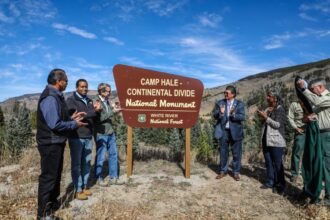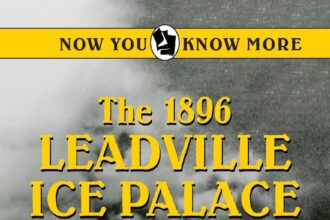A Story of Ingenuity: Leadville’s Ice Palace of 1896
In the winter of 1896, the quaint mining town of Leadville, Colorado, unveiled a stunning architectural wonder—a magnificent palace constructed entirely of ice. This captivating endeavor, designed to draw visitors from far and wide, is now the subject of a recently published book by Colorado author and historian Afton Rorvik, titled “The 1896 Leadville Ice Palace.”
Rorvik’s book recounts the ambitious decision made by Leadville’s leaders to create an extraordinary ice palace as a means to revive the struggling town, which had seen better days during the silver rush of the 1870s. Following the Silver Panic of 1893, Leadville faced economic hardship, prompting city officials to launch a unique promotional campaign. “It’s really quite a story — and it’s a true story,” Rorvik noted, reflecting on the palace’s historical relevance.
Inspiration and Construction
Rorvik, who developed a fascination for Leadville during childhood visits, delved into the history surrounding the ice palace due to its representation of human creativity and determination. Her research utilized original newspaper articles from the Herald Democrat dating back to the construction period.
“In 1895, Leadville decided it was going to build an ice palace, and it was going to be the biggest and best of its kind,” Rorvik explained. Despite lacking modern construction technology, the ambitious project was completed in just over a month, with the palace opening its doors to the public on January 1, 1896.
At the forefront of this venture was Tingley S. Wood, a respected miner who played a crucial role in fundraising and contributing his own resources. Hundreds of community members collaborated to construct the palace, and skilled craftsmen were hired to create an intricately designed framework. Local ponds and lakes provided the ice blocks, which were transported via horse-drawn sleds to the building site, demonstrating the community’s dedication and resilience.
Features of the Ice Palace
The completed palace measured an impressive 450 feet in length and 320 feet in width and included a skating rink at its center. Innovative design elements included hollow ice columns that harbored light bulbs, a remarkable feat for the time, given that electricity had only recently arrived in Leadville. The palace was not only a visual spectacle but also a social hub, warmly heated by coal-burning stoves.
Throughout its operational season, visitors traveled from afar, often taking overnight trains to experience the “Crystal Carnival” that the ice palace inspired. Rorvik shared a whimsical anecdote about “Press Day,” held on January 15, 1896, when the mayor mandated that attendees don festive costumes, threatening those without costumes with arrest.
Legacy and Memory
Unfortunately, the beauty of the ice palace was short-lived. By the end of March 1896, warmer temperatures melted the structure, and while there were discussions about annual reconstructions, financial challenges prevented any such revival. Rorvik revealed that the original project might have cost the equivalent of almost $5 million today, raising questions about the sustainability of such an elaborate creation.
Despite its demise, the Leadville ice palace remains a captivating chapter in the town’s history and a symbol of Rorvik’s dedication to preserving this unique story. The book “The 1896 Leadville Ice Palace” is available at various local retailers, including Next Page Books and the Leadville Heritage Museum.
| Feature | Details |
|---|---|
| Dimensions | 450 feet long, 320 feet wide |
| Opening Date | January 1, 1896 |
| Skating Rink | Included at the center |
| Lighting | Hollow ice columns with light bulbs |
| Construction Time | Approx. 6 weeks |
Over a century after its spectacular debut, the ice palace stands as a testament to Leadville’s spirit of innovation and remains a cherished memory among its townspeople.














